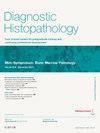Artificial intelligence and digital pathology: where are we now and what are the implementation barriers?
引用次数: 0
Abstract
Artificial intelligence (AI) has garnered significant public attention over the last few years and has become part of our everyday lives. This is no different in histopathology, with vast amounts of private and public sector investment into digital reporting and AI development. There are now several companies with commercially available AI decision support tools ready for adoption by pathologists in digitally mature laboratories. Many more pathology-oriented AI tools, with a variety of uses across the patient pathway, are on the horizon and include the possibility of multimodal integration. However, for AI in pathology to be used effectively and its benefits realized, there needs to be widespread ‘business as usual’ use of digital laboratory workflows and digital reporting. The NHS is currently undergoing a national pathology transformation programme that includes targets for digital reporting and AI ready capabilities for all laboratories in England. In this article, we provide an update on the current progress of AI development in histopathology including the AI tools currently available and potential future applications. We also discuss the ongoing implementation of digital pathology services in the NHS and highlight the barriers to building a strong foundation for AI tool deployment. This builds upon, and complements, our previous article on these issues.
人工智能和数字病理学:我们现在处于什么阶段,有哪些实施障碍?
人工智能(AI)在过去几年中引起了公众的极大关注,并已成为我们日常生活的一部分。组织病理学也不例外,私营和公共部门对数字报告和人工智能开发进行了大量投资。目前已有多家公司推出了商业化的人工智能决策支持工具,可供数字化成熟实验室的病理学家采用。还有更多面向病理学的人工智能工具即将问世,这些工具在患者的整个病程中具有多种用途,并有可能实现多模态集成。然而,要想在病理学领域有效使用人工智能并实现其优势,就必须广泛 "照常 "使用数字化实验室工作流程和数字化报告。英国国家医疗服务体系(NHS)目前正在实施一项国家病理学转型计划,其中包括为英格兰所有实验室提供数字报告和人工智能就绪能力的目标。在本文中,我们将介绍组织病理学领域人工智能发展的最新进展,包括目前可用的人工智能工具和未来可能的应用。我们还讨论了英国国家医疗服务系统(NHS)正在实施的数字病理服务,并强调了为人工智能工具部署奠定坚实基础所面临的障碍。这篇文章是对我们之前有关这些问题的文章的补充和完善。
本文章由计算机程序翻译,如有差异,请以英文原文为准。
求助全文
约1分钟内获得全文
求助全文
来源期刊

Diagnostic Histopathology
Medicine-Pathology and Forensic Medicine
CiteScore
1.30
自引率
0.00%
发文量
64
期刊介绍:
This monthly review journal aims to provide the practising diagnostic pathologist and trainee pathologist with up-to-date reviews on histopathology and cytology and related technical advances. Each issue contains invited articles on a variety of topics from experts in the field and includes a mini-symposium exploring one subject in greater depth. Articles consist of system-based, disease-based reviews and advances in technology. They update the readers on day-to-day diagnostic work and keep them informed of important new developments. An additional feature is the short section devoted to hypotheses; these have been refereed. There is also a correspondence section.
 求助内容:
求助内容: 应助结果提醒方式:
应助结果提醒方式:


